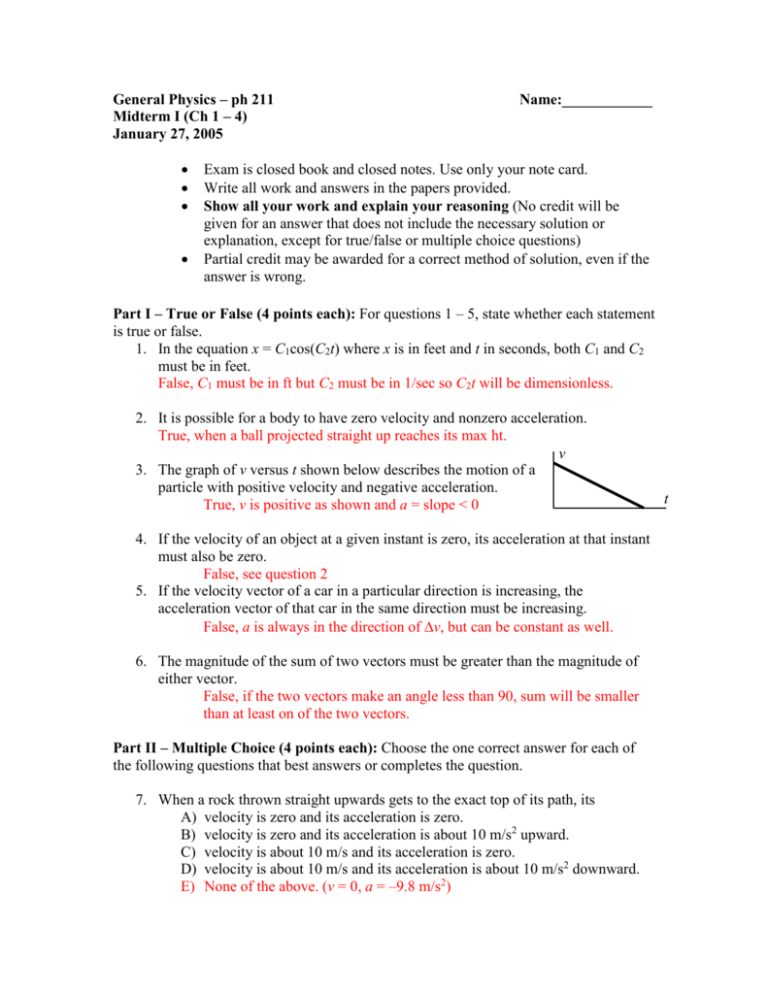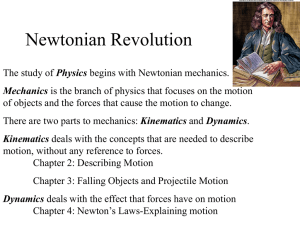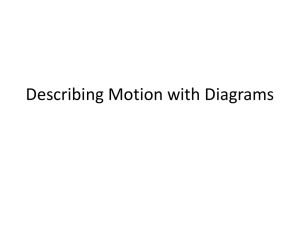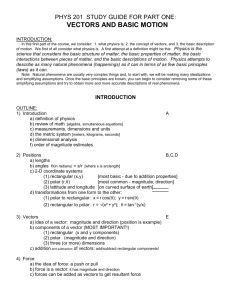General Physics – ph 211
advertisement

General Physics – ph 211 Midterm I (Ch 1 – 4) January 27, 2005 Name:____________ Exam is closed book and closed notes. Use only your note card. Write all work and answers in the papers provided. Show all your work and explain your reasoning (No credit will be given for an answer that does not include the necessary solution or explanation, except for true/false or multiple choice questions) Partial credit may be awarded for a correct method of solution, even if the answer is wrong. Part I – True or False (4 points each): For questions 1 – 5, state whether each statement is true or false. 1. In the equation x = C1cos(C2t) where x is in feet and t in seconds, both C1 and C2 must be in feet. False, C1 must be in ft but C2 must be in 1/sec so C2t will be dimensionless. 2. It is possible for a body to have zero velocity and nonzero acceleration. True, when a ball projected straight up reaches its max ht. v 3. The graph of v versus t shown below describes the motion of a particle with positive velocity and negative acceleration. True, v is positive as shown and a = slope < 0 4. If the velocity of an object at a given instant is zero, its acceleration at that instant must also be zero. False, see question 2 5. If the velocity vector of a car in a particular direction is increasing, the acceleration vector of that car in the same direction must be increasing. False, a is always in the direction of v, but can be constant as well. 6. The magnitude of the sum of two vectors must be greater than the magnitude of either vector. False, if the two vectors make an angle less than 90, sum will be smaller than at least on of the two vectors. Part II – Multiple Choice (4 points each): Choose the one correct answer for each of the following questions that best answers or completes the question. 7. When a rock thrown straight upwards gets to the exact top of its path, its A) velocity is zero and its acceleration is zero. B) velocity is zero and its acceleration is about 10 m/s2 upward. C) velocity is about 10 m/s and its acceleration is zero. D) velocity is about 10 m/s and its acceleration is about 10 m/s2 downward. E) None of the above. (v = 0, a = –9.8 m/s2) t 8. The magnitude of the displacement of an object is _______ the distance the object has traveled. A) smaller than D) either larger or smaller B) larger than E) smaller than or equal to C) the same as 9. On a graph showing velocity on the vertical axis and time on the horizontal axis, constant acceleration is represented by A) straight line with a zero slope. B) straight line with a negative slope. C) straight line with a positive slope. D) straight line with an undefined slope (vertical line). E) either A, B or C. 10. A ball is dropped from rest. If it falls a distance y1 during the first second and an additional distance y in the next second, the ratio y/y1 is A) 1 B) 2 C) 3 D) 4 E) 5 y/y1 = (y2 – y1)/y1 = y2/y1 – 1 or 1/2g(2sec)2/1/2g(1sec)2 – 1 = 3 11. Two vectors A and B are added together to form a vector C. The relationship between the magnitudes of the vectors is given by A + B = C. Which one of the following statements concerning these vectors is true? A) A and B must be displacements. B) A and B must have equal lengths. C) A and B must point in opposite directions. D) A and B must point in the same direction. E) A and B must be at right angles to each other. Part III – Problems (20 points each): Show your work clearly and completely for each of the following problems. Problem 11 The velocity – time graph of a runner moving along a straight line is shown above. The position of the runner at t = 0 is x0 = 5 m. A) How far has the runner traveled in 25 seconds? 200 m = area under curve = 8 grid squares What is the average speed of the runner during the first 15 seconds? Total distance traveled during the first 15 sec is equal to area under that portion of curve = 5 grid squares = 5 (25 m) = 125m Ave v = distance traveled/time elapsed = 125m/15sec = 8.3 m/sec C) What is acceleration of the runner during segment C? a = v/t = (5m/s – 10m/s)/(25 sec – 15 sec) - a = –1.0 m/sec2 D) What is the average acceleration during the entire running time? a = v/t = (5m/s – 0m/s)/(25 sec – 0 sec) a = 0.20 m/sec2 Draw the acceleration graph for the runner (draw to scale). Acceleration curve 3 a (m/s/s) 2 1 0 0 5 10 15 20 25 30 -1 -2 t (sec) F) Write correct algebraic expression for x(t) with appropriate numerical values. 0 – 5 sec: x(t) = ½ (2.0 m/s2) t2 5 – 15 sec: x(t) = 10m/s t 15 – 25sec: x(t) = ½ (–1.0 m/s2) t2 13. An object moves in the xy plane with constant acceleration. At t = 0 the object is at r0 3m iˆ 4m ˆj with velocity v0 . At t = 3 s its velocity has changed to v 6m / s iˆ 5m / s ˆj and has moved to position r 12m iˆ 2m ˆj . A) Find magnitude and direction of v0 . B) What is the acceleration of the object? C) What is the magnitude of the object’s displacement at t = 3 s? Ch 6 topic (2-D problem) 14. A helicopter drops a supply package to stranded people on an island. At the instant the package is dropped, the helicopter is 80 m above a clearing area and flying at 36 m/s at an angle of 37o above horizontal. Choose the origin to be on the ground and directly below the helicopter when the package is dropped. A) How long is the package in the air? B) Where does the package land? C) If the helicopter continues to fly at constant velocity, what are the coordinates of the helicopter when the package lands? Ch 6 topics (2-D problem) 15. (Bonus Problem – 5 points): A dog runs back and forth between its two owners, who are walking toward each other, each with a speed of 1.3 m/s. The dog starts running when owners are 10.0 m apart. If the dog runs with a speed of 3.0 m/s, how far has the dog traveled when the owners meet? d=vt The total time the is running is the same as the time it takes the owner reach each other at mid point (x = 5.0 m) t = 5.0 m/1.3m/s t = 3.85 sec d = 3.0 m/s . 3.85 sec d = 11.5 m










